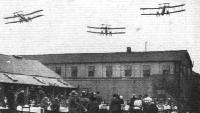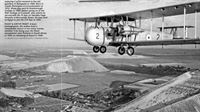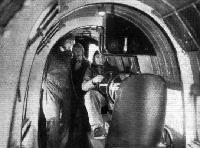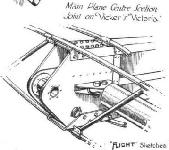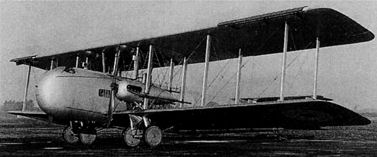
Варианты
- Vickers - Victoria - 1922 - Великобритания
- Vickers - Vanguard / Type 62 / Type 103 - 1923 - Великобритания
- Vickers - Valentia - 1934 - Великобритания
Vickers Type 56 Victoria, Type 264 Valentia и Type 72 Vanguard
Созданный на базе Virginia, военно-транспортный самолет Vickers Victoria сыграл заметную роль в истории британских ВВС. Например, он участвовал в эвакуации 586 человек из Кабула в Пешавар в 1928-1929 годах.
Два прототип Victoria были заказаны в апреле 1921 года. Первый из них, с обозначением Type 56 Victoria Mk I, поднялся в воздух 22 августа 1922 года. Этот большой самолет с крылом и оперением бипланной схемы был оснащен парой 450-сильных (336 кВт) ПД Napier Lion IXA. В его вместительном фюзеляже размещались открытая двухместная кабина для пилотов и закрытая кабина для 23 полностью снаряженных пехотинцев.
Второй прототип,Type 81 Victoria Mk II, был облетан в январе 1923 года. На первом серийном варианте, Type 117 Victoria Mk III, ввели небольшую стреловидность внешних частей консолей крыла и первоначально установили 450-сильные (336 кВт) ПД Lion II.
Обозначение Type 145 Victoria Mk IV получил прототип с цельнометаллическим каркасом крыла. За ним последовал первый крупносерийный вариант Type 169 Victoria MkV с новым крылом, 570-сильными (425 кВт) ПД Napier Lion VIIB и без килей на хвостовом оперении. Последним серийным вариантом стал Type 262 Victoria Mk VI с 622-сильными (464 кВт) радиальными ПД Bristol Pegasus IIL3. К моменту завершения выпуска Victoria построили 97 самолетов, включая прототипы.
<...>
Описание:
- Vickers Type 56 Victoria, Type 264 Valentia и Type 72 Vanguard
- Flight, July 1929
BRITISH AIRCRAFT AT OLYMPIA - Flight, November 1932
British Aircraft
Фотографии
-
Мировая Авиация 43
22 августа 1922г.: военно-транспортный Vickers Victoria стоял на вооружении 70-й и 216-й авиаэскадрилий в Северной Африке и на Ближнем Востоке, заменив Vernon и Vimy.
-
Flight 1934-06 / Flight
TROOP TRANSPORT OVERSEAS: The "Victoria" (two "Lions") carries 25 soldiers and their equipment. It is used by Nos. 216 (Bomber-Transport) Squadron at Heliopolis, Egypt, and No. 70 (B-T) Squadron at Hinaidi, Iraq.
-
Flight 1925-06 / Flight
WITH THE R.A.F. IN IRAQ: We show above one of the Vickers "Victoria" aerial transports (two 450 h.p. Napier "Lion" engines) at Hinaidi aerodrome. These machines, which can carry 25 soldiers complete with equipment, in addition to the crew of two, have done excellent work, not only in transporting troops, but in conveying sick and wounded from one part of the country to another in a matter of hours as against days by other means of transport.
-
Flight 1929-01 / Flight Advertisements
The VICKERS "VICTORIA" (Twin Napier "Lion" Engines) TROOP CARRIER used by the ROYAL AIR FORCE FOR THE EVACUATION OF CIVILIANS FROM KABUL to PESHAWAR
-
Flight 1933-12 / Flight
A SERVICE CRUISE: One of the Vickers "Victoria" troop carriers of No. 216 (Bomber Transport) Squadron. R.A.F., landing at Tambacounda during the flight to West Africa.
-
Aeroplane Monthly 1980-12 / Personal album
Регистрационный номер: J8234 Vickers Victoria III J8234 at Hinaidi. No 70 Sqn was the first RAF unit to receive this troop carrier, during August 1926, and the type remained in Iraq until replaced by Vickers Valencias in 1935.
-
Flight 1923-06 / Flight
The Vickers "Victoria," (2) 450 h.p. Napier "Lions": A large 25-seater troop-carrier - a development of the "Vimy."
-
Flight 1930-03 / Flight
Регистрационный номер: J9766 The latest version of the Vickers Victoria is fitted with two Napier "Lion XI" engines and Handley Page automatic slots. The wheels under the tail skid are temporary, and not permanent fitments.
-
Flight 1929-01 / Flight
AIR RESCUES IN AFGHANISTAN: The Vickers-Napier "Victoria" troop carrier, which has been instrumental in transferring the British and other European women and children from the danger zone of Kabul (Afghanistan) to Peshawar, India.
-
Flight 1927-06 / Flight
Vickers "Victoria" (Two Napier "Lions"). A large part of Vickers work in aviation has been the production of giant machines, and the "Victoria" is one of their largest, strongly stamped with the Vickers style. It is another member of the "Vimy" family, and is actually a very large version of the "Vimy Commercial" used some little while back on the London-Continental air services. The "Victoria," which has the same span as the "Virginia," carries two pilots and 23 troops. They are used for troop transport and ambulance work by No. 70 Squadron (Iraq) and No. 216 Squadron (Middle East).
-
Мировая Авиация 82
25 февраля 1929 года восемь самолетов Victoria и Hinaidi из 70-й эскадрильи британских ВВС эвакуировали 586 человек и 10975 кг груза из Кабула, Афганистан.
-
Aviation Historian 26 / P.Jarrett - Lost & Found
Регистрационный номер: J7928, J7929 Vickers Victoria IIIs J7929 and J7928 of No 216 Sqn in the Middle East circa 1926. The forward fuselage of the furthest machine is inscribed with a circular series of numbers from 0 to 3 and what appears to be a rotating pointer. What did it represent and what was it used for?
-
Air Pictorial 1957-08 / Photos by request
Регистрационный номер: J7922 JUST AN ILLUSION. This is not a case demanding a Court of Inquiry but simply a between-the-wars trick of the R.A.F. in the Middle East to give some welcome shade to single-seaters by manoeuvring the smaller aircraft as close as possible to the bigger 'planes. This excellent example of the manoeuvre shows a first-contract (E8249), all-silver Sopwith Snipe 7F.1 (230-h.p. Bentley B.R.2 rotary radial) of No. I (Iraq) Fighter Squadron photographed at Hinaidi, Baghdad, in 1926, sheltering under the 87-ft. 4-in. span of the second production (J7922) Vickers Victoria Mk. I (two 570-h.p. Napier Lion " broad arrow" twelve-cylinder inlines) of No. 70 (Middle East) Transport Squadron, based at Hinaidi. Note the early type of Vee-fronted rudders. Victorias could carry twenty-two troops, plus two crew, and took part in many pioneer military air lifts and long-range "showing-the-Flag" exercises. The 121-m.p.h. Snipe of 1918 remained in service until the late 1920s, and was the last R.A.F. fighter to be powered by a rotary aero engine.
Другие самолёты на фотографии: Sopwith Snipe / 7F.1 - Великобритания - 1918
-
Flight 1929-07 / Flight
Dignity and impudence are personified, on the Vickers stand, by the "Victoria" troop-carrier and the single-seater interception fighter.
Другие самолёты на фотографии: Vickers Jockey / Type 151 - Великобритания - 1930
-
Flight 1931-03 / Flight
Регистрационный номер: JR8062 THE SERVICE FLIGHT TO THE CAPE: One of the Vickers "Victoria" Troop Carriers of No. 216 (Bomber) Squadron landing at Maitland Aerodrome, Cape Town, on February 7. Table Mountain will be seen in the background.
-
Flight 1932-10 / Flight
Регистрационный номер: K2344 [2] THE SCHOOL HOUSE: This Vickers "Victoria" (Napier "Lions") is used at the Central Flying School for instrument-flying instruction.
Vickers Victoria K2344 - apparently driverless. -
Air International 1976-03 / In print
A Vickers Victoria III, the type of transport used by No 70 Squadron, RAF, to complete the first-ever airlift, as described in “Wings over Kabul”.
-
Flight 1932-06 / Flight
Регистрационный номер: K1311 -
Мировая Авиация 248
Регистрационный номер: J7924 [2] Бомбардировщик и транспортник Vickers Victoria патрулирует над северо-западной границей. Такими машинами была оснащена 45-я эскадрилья под командой Харриса.
С 1926 года Victoria заменили Vernon в качестве основного военно-транспортного самолета британских ВВС на Ближнем Востоке. Для ведения наступательных действий Victoria мог нести бомбовую нагрузку под крылом.
Vickers Victoria III J7924 is seen prior to the accident, flying over Hinaidi in 1927 With Mr Steer and V.Insoll up front. -
Aeroplane Monthly 1974-02 / Personal album
Регистрационный номер: J7966 Victoria V J9766, over typical hill country. This aircraft was the last of the initial RAF order and was delivered late 1929.
-
Flight 1930-06 / Flight
A formation of Victorias which flew over during the afternoon.
-
Flight 1923-07 / Flight
THE "STAR TURN" AT THE R.A.F. PAGEANT: Below, a small military post defending an important railway bridge is attacked by Arabs, and escapes on a Vickers Troop-Carrier, sent to their assistance. Sopwith Snipes attack the enemy whilst the garrison emplane, and a demolition party place charges to destroy the bridge, which, as soon as the Troop-Carriers and escort get away, blows up, as shown above.
Другие самолёты на фотографии: Sopwith Snipe / 7F.1 - Великобритания - 1918
-
Flight 1927-07 / Flight
THE R.A.F. DISPLAY: Bombing of the Village of "Hunyadi Janos in Irquestine." In 3, even the church has caught (in spite of the official programme). Vickers "Victorias" are seen in 3, alighting with troops and machine gun while 4 illustrates how food and medicine is dropped by parachute. Troops are deplaning in 5, and getting ready to take part in the fight, and finally, women and children are taken away to safety by the "Victorias" in 6.
-
Aeroplane Monthly 1974-09 / ??? - Hendon Pageantry 1920-37
PIRATES BOLD: ... Meanwhile "Victoria" troop carriers arrive and deplane a small force who capture the surviving Pirates and salve the booty.
-
Flight 1933-12 / Flight
THE VICEROY IN JODHPUR: For the first time in history a Viceroy has arrived in state by air in the Rajputana State of Jodhpur. H.E. Lord Willingdon, accompanied by Her Excellency and staff, arrived there in his own Avro 10. In his speech at the official banquet His Excellency said that Jodhpur Aerodrome was an important link in the chain of Imperial communications and was one of the finest in the East, being equipped with an excellent hotel and every modern necessity for air transport. He also mentioned that there were 15 landing grounds in the State. He congratulated His Highness the Maharaja on the achievements or his ten years' rule.
-
Aviation Historian 21 / R.Shaw - The Grand Tour
A typically vivid Charles E. Brown photo of a Vickers Victoria loading up at Heliopolis in the 1930s;
-
Aviation Historian 21 / R.Shaw - The Grand Tour
A keen photographer, the author kept a remarkable record of his many travels, whether it be flying over the Rand escarpment near Pretoria in South Africa in 1934, or refuelling at Asyut in 1935.
-
Aeroplane Monthly 1979-01
Регистрационный номер: K3159 Vickers Victoria VI K3159 of 70 Squadron, RAF, was photographed by The Aeroplane before it was converted to a Valentia in November 1935. It met its end on April 4, 1936, when it was hit by a flare and caught fire.
-
Aviation Historian 21 / R.Shaw - The Grand Tour
Регистрационный номер: K2807 Originally built as a Victoria Mk V, K2807 (No 1 on the tour) is seen here overflying the outskirts of Nairobi on March 2, 1934. The Victoria VI was essentially a Mk V with Bristol Pegasus engines replacing the original Napier Lions. With further structural strengthening the type was redesignated as the Valentia Mk I, and many Vs and VIs were ultimately converted to Valentia standard.
-
Aviation Historian 21 / R.Shaw - The Grand Tour
Victoria No 2 over Pretoria, the administrative capital of the Union of South Africa, where the tour arrived to great fanfare on March 8, 1934. The city was looking its best, as the squadron’s arrival in Pretoria coincided with a visit by HRH The Prince George, a keen advocate of aviation, who was on an official tour of South Africa.
-
Aviation Historian 21 / R.Shaw - The Grand Tour
Регистрационный номер: K2343 [2] A keen photographer, the author kept a remarkable record of his many travels, whether it be flying over the Rand escarpment near Pretoria in South Africa in 1934, or refuelling at Asyut in 1935.
-
Aviation Historian 21 / R.Shaw - The Grand Tour
Регистрационный номер: K2343 [2] Resplendent above the clouds, Kilimanjaro recedes from view through the airframe of Victoria VI K2343, the author’s aircraft, probably after take-off from Moshi. At 19,000ft (5,800m), the perpetually snow-covered peak of Kilimanjaro would have been beyond the Victoria’s own absolute ceiling of 18,500ft. Next stop Dodoma ...
-
Aviation Historian 21 / R.Shaw - The Grand Tour
As the flight proceeded southwards the terrain changed from the sandy desert of northern Africa to the savanna grasslands of Sudan and on to the mountains of the Eastern Rift range, of which Mount Kilimanjaro is the highest point. The port Pegasus of the author’s Victoria frames a magnificent view of a snow-capped peak.
-
Aviation Historian 21 / R.Shaw - The Grand Tour
One of the series of photographs taken by the author from his Victoria during the squadron’s visit to Livingstone in Northern Rhodesia. It shows, appropriately enough, Victoria Falls and the distinctive arch of the Victoria Falls Bridge, which was opened in 1905 and straddles the border of what are now Zimbabwe and Zambia.
-
Aviation Historian 21 / R.Shaw - The Grand Tour
A group portrait of No 216 Sqn in front of a Victoria VI at Heliopolis, Egypt, in 1934. The author is seated in the front row, fourth from left, as enlarged in the inset LEFT. The unit had long been established in Egypt, initially bringing its Airco D.H.10s to Qantara in 1919 before moving two years later to Heliopolis, from where it operated for the next 20 years
-
Aeroplane Monthly 1983-12 / L.Coombs - Cockpits of the RAF (3)
The capacious cabin of a troop-carrying Vickers Victoria held 23 passengers behind a crew of two, whose cockpit was open to the sky. Two clocks and an ETA placard added to the troops’ comfort and enjoyment.
-
Flight 1932-10 / Flight
Регистрационный номер: K2344 [2] THE SCHOOL ROOM: A view inside the "Victoria" showing the unique "back to front" arrangement for instruction.
The fiendish instrument-flying cockpit installed in Vickers Victoria K2344. -
Aviation Historian 21 / R.Shaw - The Grand Tour
The remarkably clean interior of a Victoria (probably a factory-fresh example), looking aft. The type was originally designed to a specification drafted in 1920 for a troop-carrying aeroplane capable of carrying 25 fully-armed soldiers at 100 m.p.h. (160km/h) for 400 miles (640km). The prototype made its first flight in August 1922.
-
Aeroplane Monthly 1974-02 / Personal album
Регистрационный номер: K3164 Victoria VI K3164, delivered in late 1933.
-
Aeroplane Monthly 1974-02 / Personal album
Регистрационный номер: K2794 Victoria V K2794 with back broken at Hinaidi in 1935. This aircraft was delivered to the RAF late in 1932 and later converted to a Valentia.
-
Aeroplane Monthly 1974-02 / Personal album
A Victoria in the process of burning out at Fallujah in February 1936.
-
Aeroplane Monthly 1974-02 / Personal album
A Victoria after an accident with a Very light at Fallujah.
-
Aeroplane Monthly 1974-02 / Personal album
The havoc a two-minute dust devil could inflict on an unsuspecting Victoria.
-
Aeroplane Monthly 1974-02 / Personal album
The havoc a two-minute dust devil could inflict on an unsuspecting Victoria.
-
Aeroplane Monthly 1980-12 / Personal album
Регистрационный номер: J7924 [2] Vickers Victoria III J7924 after a gale had wrapped it up into a ball at Ur on May 22, 1928. At the time the aircraft was on operations over the Southern Desert and was flown by V.Insoll.
-
Flight 1930-12 / Flight
EVACUATION OF INHABITANTS OF KABUL: This picture is a reproduction of a painting by Mr. Johns, representing Vickers "Victoria" Troop Carriers with Napier engines flying over the Kabul-Peshawar area. A reproduction in colour of this painting has been issued jointly by Vickers (Aviation), Ltd., and D. Napier & Son. Ltd., and we are asked to state that on application to Vickers from any of the officers and personnel of the R.A.F., &c, who took part in the Kabul operations, a copy of the reproduction will be sent, post free.
-
Flight 1929-07 / Flight
On the Vickers "Victoria": The upper sketch shows spar hinge for folding the wings. Note how fabric is laced, and also interplane strut attachment. Below a typical fuselage joint in metal.
-
Flight 1929-07 / Flight
In many Vickers machines use is made of a special form of spar construction, with channel section flanges and zig-zag webs.
-
Flight 1929-07 / Flight
The ribs on the "Victoria" are of duralumin tube. The metal covering in certain places reinforces the ribs and also serves as a platform for walking to engines, etc.
-
Flight 1929-07 / Flight
The interplane struts on the "Victoria" are formed from thick duralumin sheet, riveted along both edges.
-
Flight 1929-08 / Flight
Main Plane Centre Section Joint on Vickers's "Victoria"
-
Flight 1929-07 / Flight
Vickers Victoria IV 2 Napier "Lion" Engines
- Фотографии




















